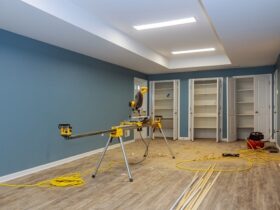Home improvement projects are a great way to add value to your property, improve your living space, and even boost your mood. However, without proper planning and execution, these projects can quickly turn into a nightmare. Let’s explore the top seven home improvement mistakes you should avoid to ensure your project is a success.
Mistake 1: Not Planning Properly
Proper planning is the cornerstone of any successful home improvement project. Without detailed plans, you may find yourself running out of time, money, or both.
Lack of Detailed Plans
Starting a project without a clear plan can lead to unexpected issues. From running out of materials to discovering structural problems, detailed planning helps prevent surprises.
Ignoring Budget Constraints
It’s easy to get carried away with home improvement ideas, but ignoring your budget can lead to financial strain. Always allocate a portion of your budget for unforeseen expenses.
Underestimating Project Timeframes
Home improvement shows make everything look quick and easy, but real-life projects often take longer than expected. Always add extra time to your project schedule to account for delays.
Mistake 2: Skipping Permits and Regulations
Understanding Local Building Codes
Local building codes are there to ensure safety and compliance. Skipping permits can lead to fines, delays, and even the need to redo the work.
Consequences of Ignoring Permits
Ignoring permits can result in hefty fines and legal issues. More importantly, non-compliant work can pose safety hazards and decrease your home’s value.
How to Ensure Compliance
Before starting any project, research local regulations and obtain necessary permits. Consulting with a professional can also help ensure all work is up to code.
Mistake 3: Choosing the Wrong Contractors
Importance of Vetting Contractors
Choosing the right contractor can make or break your project. Always vet potential contractors thoroughly.
Red Flags to Watch For
Be wary of contractors who request large upfront payments, lack proper licensing, or have poor reviews. These are signs of potential issues down the road.
How to Find Reliable Professionals
Seek recommendations from friends and family, check online reviews, and ask for references. A reliable contractor will be transparent about their work and provide a detailed contract.
Mistake 4: Cutting Corners on Materials
Long-Term Impact of Cheap Materials
Using cheap materials might save money upfront, but it can lead to costly repairs and replacements in the future.
Balancing Cost and Quality
Investing in quality materials can increase the longevity and value of your improvements. Look for materials that offer the best balance of cost and durability.
Examples of Where Quality Matters Most
Areas like roofing, flooring, and plumbing benefit greatly from high-quality materials. These elements endure significant wear and tear and should be built to last.
Mistake 5: Overlooking Safety Precautions
Common Safety Hazards
Home improvement projects come with various risks, including falls, cuts, and exposure to hazardous materials.
Essential Safety Measures
Always wear appropriate safety gear, secure ladders and tools, and ensure the workspace is well-lit and clutter-free.
Protecting Your Family and Property
If you’re undertaking major renovations, consider temporary relocation to protect your family from dust, noise, and potential accidents.
Mistake 6: Ignoring Energy Efficiency
Benefits of Energy-Efficient Upgrades
Energy-efficient improvements can lower utility bills and reduce your environmental footprint.
Common Energy Wasting Practices
Old windows, poor insulation, and outdated appliances are common culprits of energy waste.
How to Improve Energy Efficiency
Upgrading to energy-efficient windows, adding insulation, and using ENERGY STAR-rated appliances can make a significant difference.
Mistake 7: Not Considering Resale Value
Understanding Market Trends
While personalizing your space is important, overly unique features can deter future buyers.
Home Improvements that Add Value
Focus on improvements that appeal to a broad audience, such as kitchen remodels, updated bathrooms, and increased curb appeal.
Avoiding Overpersonalization
Keep future resale in mind by choosing neutral colors and timeless designs that won’t go out of style.
Why Do Home Improvement Mistakes Occur?
Home improvement mistakes occur for a variety of reasons, often stemming from a lack of preparation, expertise, or awareness. Here are some common reasons why these mistakes happen:
Inadequate Planning:
One of the primary reasons is insufficient planning. Homeowners may rush into a project without fully understanding the scope, requirements, or potential challenges. Without a detailed plan, it’s easy to overlook important details and make costly errors.
Budget Constraints:
Financial limitations can lead to compromises on quality, materials, or professional help. Attempting to cut costs by using cheaper materials or unskilled labor often results in subpar work that needs to be redone, ultimately costing more.
Lack of Experience:
Many homeowners overestimate their DIY skills and tackle projects beyond their capabilities. Without the proper knowledge or experience, they may make mistakes that a professional would avoid, leading to poor workmanship and safety hazards.
Skipping Permits and Regulations:
Ignoring the need for permits and adherence to local building codes can lead to significant issues. Unpermitted work can result in fines, legal troubles, and unsafe structures that do not meet safety standards.
Poor Contractor Selection:
Choosing the wrong contractor is another common mistake. Rushing the selection process or failing to thoroughly vet contractors can result in hiring unqualified or unreliable individuals, leading to delays, increased costs, and unsatisfactory results.
Underestimating Time and Effort:
Home improvement projects often take longer and require more effort than anticipated. Misjudging the time needed can lead to rushed work, which increases the likelihood of mistakes and oversights.
Ignoring Safety Precautions:
Safety is often overlooked in the excitement of starting a project. Failing to take necessary safety measures can result in accidents, injuries, and damage to property, which can derail the project and add unexpected costs.
Lack of Communication:
Poor communication between homeowners, contractors, and other involved parties can lead to misunderstandings, errors, and unmet expectations. Clear and consistent communication is essential to avoid mistakes.
Overpersonalization:
While personalizing your home is important, making overly unique or unconventional choices can negatively impact the home’s resale value and appeal. It’s crucial to balance personal preferences with considerations of what will be attractive to future buyers.
Ignoring Maintenance Needs:
Overlooking the ongoing maintenance requirements of new installations or renovations can lead to premature deterioration and additional costs. Proper maintenance is essential to ensure the longevity and performance of home improvements.
FAQs about Home Improvement Mistakes to Avoid
The most common mistake is failing to plan properly, leading to budget overruns, delays, and incomplete projects.
Create a detailed budget that includes a contingency fund for unexpected expenses. Stick to your budget by avoiding unnecessary changes once the project begins.
Permits ensure that your project complies with local building codes, which are designed to ensure safety and quality. Skipping permits can lead to legal issues and decreased property value.
Choose contractors based on recommendations, reviews, and proper licensing. Always get multiple quotes and check references before making a decision.
Consider upgrading to energy-efficient windows, adding insulation, and using ENERGY STAR-rated appliances to improve your home’s energy efficiency.
Conclusion
Avoiding these common mistakes can help ensure your home improvement project is successful and stress-free. Thoughtful planning, adherence to regulations, and quality investments are key. When in doubt, seek professional advice to guide you through the process.









Find Us on Socials